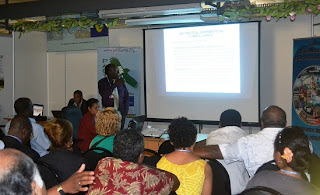Newslink: http://www.eenews.net/cw/
Lisa Friedman, E&E reporter
Published: Thursday, December 1, 2011
Lisa Friedman, E&E reporter
Published: Thursday, December 1, 2011
The United States spent more than four times as much money on clean technology investment as it did protecting vulnerable countries from the impact of climate change, according to a new
report the Obama administration released today at climate talks in Durban, South Africa.
Of the $3.1 billion the U.S. says it devoted to climate change efforts in 2011, about $563 million went toward helping poor communities build resilience to weather disasters. Meanwhile, $2.5
billion went toward a variety of programs to steer developing nations toward clean energy, mitigate carbon emissions and develop new renewable technologies.
The detailed accounting shows the U.S. on a path to meeting its unofficial share of commitment wealthy nations made at the 2009 Copenhagen climate summit of $30 billion by 2012. Though nations were not allocated specific amounts, the U.S. expectation for most foreign aid accounts is roughly 20 percent.
Environmental groups said they are pleased that the administration is fighting for international climate aid and using existing programs to help address clean energy needs. But they also warned that some aid is undermining climate change efforts -- particularly through the Export-Import Bank -- and cautioned that adaptation needs are in danger of being pushed aside.
"We're certainly disappointed. It seems to be going in the wrong direction," said David Waskow, international climate change policy director at Oxfam America. He estimated the share of 2011 dollars going toward making communities resilient to climate change at just 18 percent.
In 2011, the administration said, it devoted $3.1 billion to global climate aid, bringing its total contribution so far to $5.1 billion. The funding is split between $1.8 billion in congressionally appropriated dollars and $1.3 billion in loan guarantees and other export agency finance measures.
Bulk of aid through loans, loan guarantees
Loans, loan guarantees and other financing from the Export-Import Bank and the Overseas Private Investment Corporation was a cornerstone of the U.S. aid efforts and is expected to grow. Last year OPIC directed $310 million in financing to double the generating capacity of a geothermal plant in Kenya and invested $250 million in the development of solar projects in Thailand.
The Export-Import Bank, meanwhile, authorized $84.3 in loans to finance solar photovoltaic modules and equipment in Rajasthan, India. In all, the OPIC and ExIm Bank investments leveraged more than $2.3 billion in private investment, the administration said.
Waskow argued that the presence of so much private investment in clean technology is yet another reason the U.S. should put its resources into areas where business has little interest in
investing: keeping poor communities safe from weather-related disasters. "For the majority of countries, their greatest interest is in resilience and adaptation," he said.
Others, meanwhile, noted that while the U.S. statement played up clean energy development, it failed to mention massive coal and other fossil fuel investments. Of particular concern to environmentalists is U.S. underwriting to the tune of $805 million the Kusile coal-fired power plant near Johannesburg, South Africa.
The 4,800-megawatt power station will emit 30 million metric tons of carbon dioxide every year.
Meanwhile yesterday the African Climate Policy Center blasted developed countries and claimed that of the money put forward, less than $7 billion of it is new funding.
African nations say vulnerability outpaces aid "African countries, as well as many other developing countries, are vulnerable to climate change and are among those least likely to have the resources required to withstand its adverse impacts -- yet there has not been any indication that the magnitude of climate finance will meet the scale of what is needed." Seyni Nafo, Spokesperson of the African Group said in a statement.
The report stands in contrast to a World Resources Institute report that found nation's pledges already reach more than $28 billion.
Jake Schmidt, international climate policy director at the Natural Resources Defense Council, acknowledged that many governments are counting old dollars -- but also noted that a number of countries began ramping up climate aid before Copenhagen because they knew more funding would be a key point for poor countries. The fact that some money is not new, he said, is less important than whether the dollars are used well.
"Here's the reality. The fast start funding commitment was made in December of 2009. As of January 1, all of a matter of two weeks after, they were supposed to have turned the pledge into firm legislation with money from their treasuries," Schmidt said.
The U.S. share, he said, is a "mixed bag." He praised the Obama administration for fighting to keep climate aid in the budget, but also warned against fossil fuel loans from ExIm and others.
"It is critical that all the money we have flowing is not digging us deeper into the hole but helping us to solve it."










